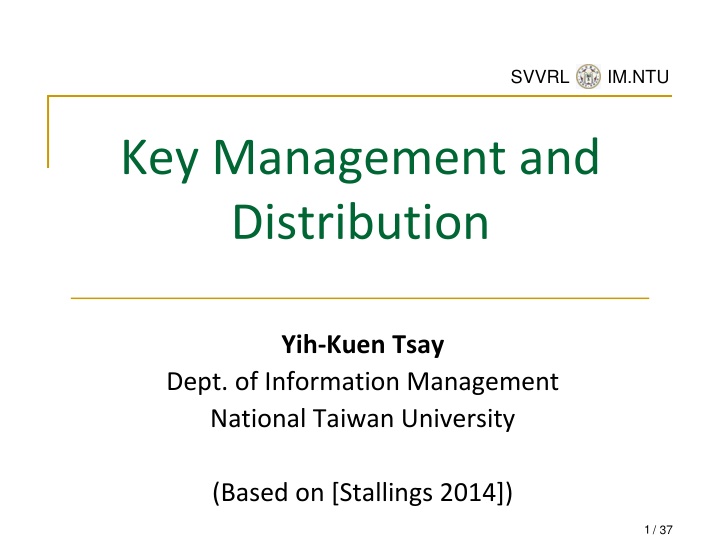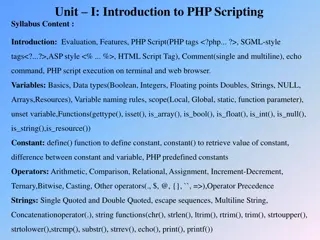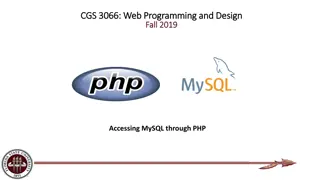
Key Management and Distribution Techniques at National Taiwan University
Explore the importance of key management and distribution in ensuring secure data exchange at National Taiwan University. Learn about symmetric key distribution, hierarchical key control, and more. Discover the strategies to protect keys and limit data compromise in encryption processes.
Download Presentation

Please find below an Image/Link to download the presentation.
The content on the website is provided AS IS for your information and personal use only. It may not be sold, licensed, or shared on other websites without obtaining consent from the author. If you encounter any issues during the download, it is possible that the publisher has removed the file from their server.
You are allowed to download the files provided on this website for personal or commercial use, subject to the condition that they are used lawfully. All files are the property of their respective owners.
The content on the website is provided AS IS for your information and personal use only. It may not be sold, licensed, or shared on other websites without obtaining consent from the author.
E N D
Presentation Transcript
SVVRL @ IM.NTU Key Management and Distribution Yih-Kuen Tsay Dept. of Information Management National Taiwan University (Based on [Stallings 2014]) 1 / 37
SVVRL @ IM.NTU Key Distribution Technique The term refers to the means of delivering a key to two parties who wish to exchange data without allowing others to see the key Why is it needed? For symmetric encryption to work, the two parties to an exchange must share the same key, and that key must be protected from access by others Frequent key changes are desirable to limit the amount of data compromised if an attacker learns the key Yih-Kuen Tsay (IM.NTU) IS 2016: Key Management 2 / 37
SVVRL @ IM.NTU Symmetric Key Distribution A can select a key and physically deliver it to B A third party can select the key and physically deliver it to A and B If A and B have previously and recently used a key, one party can transmit the new key to the other, encrypted using the old key If A and B each has an encrypted connection to a third party C, C can deliver a key on the encrypted links to A and B Given parties A and B, key distribution can be achieved in a number of ways: Yih-Kuen Tsay (IM.NTU) IS 2016: Key Management 3 / 37
SVVRL @ IM.NTU Yih-Kuen Tsay (IM.NTU) IS 2016: Key Management 4 / 37
SVVRL @ IM.NTU Yih-Kuen Tsay (IM.NTU) IS 2016: Key Management 5 / 37
SVVRL @ IM.NTU Yih-Kuen Tsay (IM.NTU) IS 2016: Key Management 6 / 37
SVVRL @ IM.NTU Hierarchical Key Control For communication among entities within the same local domain, the local KDC is responsible for key distribution If two entities in different domains desire a shared key, then the corresponding local KDC s can communicate through a global KDC The hierarchy can be of three or more layers A hierarchy minimizes the effort involved in master key distribution, because most master keys are those shared by a local KDC with its local entities Limits the range of a faulty or subverted KDC to its local area only Yih-Kuen Tsay (IM.NTU) IS 2016: Key Management 7 / 37
SVVRL @ IM.NTU Session Key Lifetime For connection-oriented protocols one choice is to use the same session key for the length of time that the connection is open, using a new session key for each new session A security manager must balance competing considerations: For a connectionless protocol there is no explicit connection initiation or termination, thus it is not obvious how often one needs to change the session key The distribution of session keys delays the start of any exchange and places a burden on network capacity The more frequently session keys are exchanged, the more secure they are Yih-Kuen Tsay (IM.NTU) IS 2016: Key Management 8 / 37
SVVRL @ IM.NTU Yih-Kuen Tsay (IM.NTU) IS 2016: Key Management 9 / 37
SVVRL @ IM.NTU Yih-Kuen Tsay (IM.NTU) IS 2016: Key Management 10 / 37
SVVRL @ IM.NTU Controlling Key Usage The concept of a key hierarchy and the use of automated key distribution techniques greatly reduce the number of keys that must be manually managed and distributed It may also be desirable to impose some control on the way in which automatically distributed keys are used For example, in addition to separating master keys from session keys, we may wish to define different types of session keys on the basis of use Yih-Kuen Tsay (IM.NTU) IS 2016: Key Management 11 / 37
SVVRL @ IM.NTU Key Controls Associate a tag with each key For use with DES and making use of the extra 8 bits in each 64-bit DES key The eight non-key bits ordinarily reserved for parity checking form the key tag As the tag is embedded in the key, it is encrypted along with the key when that key is distributed, thus providing protection Drawbacks: The tag length is limited to 8 bits, limiting its flexibility and functionality Because the tag is not transmitted in clear form, it can be used only at the point of decryption, limiting the ways in which key use can be controlled Yih-Kuen Tsay (IM.NTU) IS 2016: Key Management 12 / 37
SVVRL @ IM.NTU Yih-Kuen Tsay (IM.NTU) IS 2016: Key Management 13 / 37
SVVRL @ IM.NTU Simple Key Distribution Using Asymmetric Encryption But the scheme is vulnerable to man-in-the-middle attacks. Yih-Kuen Tsay (IM.NTU) IS 2016: Key Management 14 / 37
SVVRL @ IM.NTU Man-in-the-Middle Attack Yih-Kuen Tsay (IM.NTU) IS 2016: Key Management 15 / 37
SVVRL @ IM.NTU Secret Key Distribution with Confidentiality and Authentication Yih-Kuen Tsay (IM.NTU) IS 2016: Key Management 16 / 37
SVVRL @ IM.NTU A Hybrid Scheme In use on IBM mainframes Retains the use of a key distribution center (KDC) that shares a secret master key with each user and distributes secret session keys encrypted with the master key A public-key scheme is used to distribute the master keys Performance Backward compatibility Rationale: Yih-Kuen Tsay (IM.NTU) IS 2016: Key Management 17 / 37
SVVRL @ IM.NTU Distribution of Public Keys Several techniques have been proposed for the distribution of public keys. They may be grouped into the following schemes: Publicly available directory Public announcement Public-key authority Public-key certificates Yih-Kuen Tsay (IM.NTU) IS 2016: Key Management 18 / 37
SVVRL @ IM.NTU Public Announcement Yih-Kuen Tsay (IM.NTU) IS 2016: Key Management 19 / 37
SVVRL @ IM.NTU Yih-Kuen Tsay (IM.NTU) IS 2016: Key Management 20 / 37
SVVRL @ IM.NTU Yih-Kuen Tsay (IM.NTU) IS 2016: Key Management 21 / 37
SVVRL @ IM.NTU Certificates The public-key authority could somehow become the bottleneck of performance An alternative is to use certificates They work reliably as if the keys were obtained directly from a public-key authority A certificate essentially consists of: A public key An identifier of the key owner The whole block signed by a trusted certificate authority Yih-Kuen Tsay (IM.NTU) IS 2016: Key Management 22 / 37
SVVRL @ IM.NTU Yih-Kuen Tsay (IM.NTU) IS 2016: Key Management 23 / 37
SVVRL @ IM.NTU X.509 Certificates Part of the X.500 series of recommendations that define a directory service The directory is a server or distributed set of servers that maintains a database of information about users X.509 defines a framework for the provision of authentication services by the X.500 directory to its users Was initially issued in 1988 with the latest revision in 2000 Based on the use of public-key cryptography and digital signatures Yih-Kuen Tsay (IM.NTU) IS 2016: Key Management 24 / 37
SVVRL @ IM.NTU X.509 Certificates (cont.) Does not dictate the use of a specific algorithm but recommends RSA Does not dictate a specific hash algorithm Each certificate contains the public key of a user and is signed with the private key of a trusted certification authority X.509 defines alternative authentication protocols based on the use of public-key certificates Yih-Kuen Tsay (IM.NTU) IS 2016: Key Management 25 / 37
SVVRL @ IM.NTU Yih-Kuen Tsay (IM.NTU) Source: Figure 14.14 in [Stallings 2014]. IS 2016: Key Management 26 / 37
SVVRL @ IM.NTU Version Serial number Certificates Signature algorithm identifier Issuer name Created by a trusted Certification Authority (CA) and have the following elements: Period of validity Subject name Subject s public-key information Issuer unique identifier Subject unique identifier Extensions Signature Yih-Kuen Tsay (IM.NTU) IS 2016: Key Management 27 / 37
SVVRL @ IM.NTU Yih-Kuen Tsay (IM.NTU) IS 2016: Key Management 28 / 37
SVVRL @ IM.NTU Obtaining a Certificate User Any user with access to the public key of the CA can verify the user public key that was certified No party other than the certification authority can modify the certificate without this being detected certificates generated by a CA have the following characteristics: Because certificates are unforgeable, they can be placed in a directory without the need for the directory to make special efforts to protect them In addition, a user can transmit his or her certificate directly to other users Once B is in possession of A s certificate, B has confidence that messages it encrypts with A s public key will be secure from eavesdropping and that messages signed with A s private key are unforgeable Yih-Kuen Tsay (IM.NTU) IS 2016: Key Management 29 / 37
SVVRL @ IM.NTU Yih-Kuen Tsay (IM.NTU) IS 2016: Key Management 30 / 37
SVVRL @ IM.NTU Certificate Revocation Each certificate includes a period of validity Typically, a new certificate is issued just before the expiration of the old one It may be desirable on occasion to revoke a certificate before it expires, for one of the following reasons: The user s private key is assumed to be compromised The user is no longer certified by this CA The CA s certificate is assumed to be compromised Each CA must maintain a list consisting of all revoked but not expired certificates issued by that CA These lists should be posted on the directory Yih-Kuen Tsay (IM.NTU) IS 2016: Key Management 31 / 37
SVVRL @ IM.NTU X.509 Version 3 Version 2 format does not convey all of the information that recent design and implementation experience has shown to be needed Each extension consists of: Rather than continue to add fields to a fixed format, standards developers felt that a more flexible approach was needed An An extension value extension identifier Version 3 includes a number of optional extensions A criticality indicator The certificate extensions fall into three main categories: Key and policy information Subject and issuer attributes Certification path constraints Yih-Kuen Tsay (IM.NTU) IS 2016: Key Management 32 / 37
SVVRL @ IM.NTU Key and Policy Information These extensions convey additional information about the subject and issuer keys plus indicators of certificate policy A certificate policy is a named set of rules that indicates the applicability of a certificate to a particular community and/or class of application with common security requirements Included are: Authority key identifier Subject key identifier Key usage Private-key usage period Certificate policies Policy mappings Yih-Kuen Tsay (IM.NTU) IS 2016: Key Management 33 / 37
SVVRL @ IM.NTU Certificate Subject and Issuer Attributes These extensions support alternative names, in alternative formats, for a certificate subject or certificate issuer Can convey additional information about the certificate subject to increase a certificate user s confidence that the certificate subject is a particular person or entity The extension fields in this area include: Subject alternative name Issuer alternative name Subject directory attributes Yih-Kuen Tsay (IM.NTU) IS 2016: Key Management 34 / 37
SVVRL @ IM.NTU Certification Path Constraints These extensions allow constraint specifications to be included in certificates issued for CAs by other CAs The constraints may restrict the types of certificates that can be issued by the subject CA or that may occur subsequently in a certification chain The extension fields in this area include: Basic constraints Name constraints Policy constraints Yih-Kuen Tsay (IM.NTU) IS 2016: Key Management 35 / 37
SVVRL @ IM.NTU Yih-Kuen Tsay (IM.NTU) IS 2016: Key Management 36 / 37
SVVRL @ IM.NTU PKIX Management Functions PKIX identifies a number of management functions that potentially need to be supported by management protocols: Registration Initialization Certification Key pair recovery Key pair update Revocation request Cross certification Yih-Kuen Tsay (IM.NTU) IS 2016: Key Management 37 / 37






















